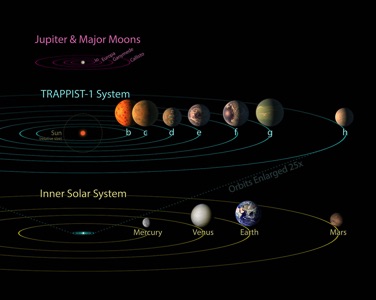The TRAPPIST-1 star is an ultra-cool red dwarf of spectral class M8. It is approximately 8% of the mass of our sun, and 11% of its diameter, making it slightly larger, but 84 times more massive than Jupiter. Red dwarf stars age far more slowly than hotter, larger stars. TRAPPIST-1 has an estimated surface temperature of 2,550 K, and is about 500 million years into a 12 trillion year life-span. By comparison, our Sun’s surface is 5778 K, and is about halfway through a 10 billion year life-span.
Long-lasting stars intrigue exobiologists because they allow so much time for life to arise and evolve. But at only 500 million years old, the TRAPPIST-1 star may be too young for life to have arisen already.
The TRAPPIST-1 star shines with only 0.000373% of the visible light that the Sun emits. It emits proportionately more infrared radiation than our sun. Viewed from the surfaces of orbiting planets, the star would glow a dull red. The habitable zone for TRAPPIST-1 extends 4 to 7 million km from the star, enough for three of the planets to occupy it.
The size of the Trappist-1 Solar System is one of the remarkable features of it. Not only is the star Jupiter-sized, but the bounty of planets around it fit within a volume of space roughly three times larger than the orbits of Jupiter’s four Galilean moons. The outermost star, TRAPPIST-1h, orbits only one-sixth as far from its star than Mercury does from our Sun!
The Nearest Exoplanet
The nearest known exoplanet is located just 4.2 light-years from Earth and circles the closest star to our Sun - Proxima Centauri - a small red dwarf star that is part of a triple star system known as Alpha Centauri. The exoplanet, known as Proxima Centauri b, has a mass 1.3 times the Earth (indicating it might be rocky) and orbits within the habitable zone of its star every 11.5 days at a distance of about one-tenth the space between Mercury and the Sun.
The TRAPPIST-1 Stellar Neighborhood
The TRAPPIST-1 system is 39 light-years from our Sun. Let's explore the local group of stars within 50 light-years of our Sun.
- Click here to view the stars within 50 light-years of the Sun.
The view in the main window now displays a 3-dimensional set of reference axes and a reference plane for the ecliptic coordinate system. The Trappist-1 star has been selected and has its position highlighted on the 3D grid. Notice that the Trappist-1 star is slightly above the ecliptic plane. As seen from Earth, TRAPPIST-1 will be 'north' of the ecliptic.
- Click here to view the names of the stars within 50 light-years of the Sun. You can point and click on any star to plot it on the reference grid.
- Click here to view the proper motion vectors of the stars within 50 light-years of the Sun.
- Click here to view the stars moving relative to each other over a time span of thousands of years.
